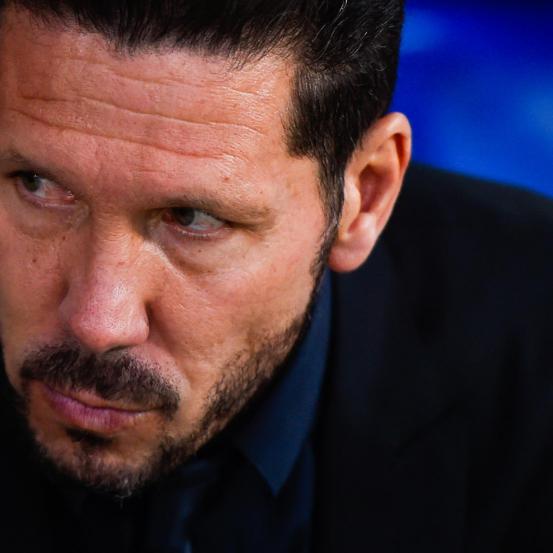- Commissioner’s statement on Ventura, Marte
- Ronnie O’Sullivan: Masters champion ‘felt so vulnerable’ in final
- Arron Fletcher Wins 2017 WSOP International Circuit Marrakech Main Event ($140,224)
- Smith challenges Warner to go big in India
- Moncada No. 1 on MLB Pipeline’s Top 10 2B Prospects list
- Braves land 2 on MLB Pipeline’s Top 10 2B Prospects list
- Kingery makes MLB Pipeline’s Top 10 2B Prospects list
- New Zealand wrap up 2-0 after Bangladesh implosion
- Mathews, Pradeep, Gunathilaka to return to Sri Lanka
- Elliott hopes for rain for Poli
Diego Simeone’s Atletico Taking Europe by Storm, but This Is Not a Revolution
- Updated: May 6, 2016

It’s been on T-shirts, banners, hats, mugs, political material and countless other things. Instantly recognisable, it has been described by the Maryland Institute of Art as “the most famous photograph in the world,” while a book dedicated to it insists it’s as iconic as the Nike swoosh or McDonald’s golden arches.
And now, Diego Simeone was on it.
It was the Friday between the first and second legs of the UEFA Champions League semi-finals, and the football community was busy marvelling at Atletico Madrid. Less than 48 hours earlier, Atletico had repelled Bayern Munich, suffocating them, infuriating them and demoralising them.
In fact, “repel” probably sells it short. “Rebel against” might be better.
On the banks of Madrid’s Manzanares river, where the shabby and dated Vicente Calderon hangs above a motorway, Bayern had arrived with all their staggering power, resources and reputation, but it hadn’t mattered. Not at all. Just like it hadn’t mattered for Barcelona.
Yeah, this Barcelona. And this Bayern.
So then came the Friday, and with it that image, “the most famous photograph in the world”: Alberto Korda’s shot from 1960 of Argentinian revolutionary Che Guevara, splashed across the cover of Gazzetta dello Sport in Italy. Except it wasn’t Guevara; Simeone’s face had been imposed onto the image.
“Commander Simeone: Cholismo and the revolt against tiki-taka,” read the headline.
A revolt? A revolution?
Oggi in #primapagina il tecnico del momento, la lite che divide i soci del @acmilan e il caso che scuote l’atletica pic.twitter.com/mBkgLQ1ySa
— LaGazzettadelloSport (@Gazzetta_it) April 28, 2016
If some see it as such, it’s hardly surprising.
What Simeone is currently achieving at Atletico is nothing short of astonishing. An Atletico legend as a player, the Argentinian took over the club in late 2011 when it was a mess, the whole thing fractured and directionless.
In the league, Atleti were handcuffed to mid-table mediocrity. In the cup, they’d just been dumped out by Albacete from the cash-less Spanish third tier. On every level, they looked like a club in crisis, gripped by massive debt, held back by a merry-go-round of managers and playing staff, and too busy getting in their own way.
Then: Cholismo.
By the end of that season, Atleti had won the Europa League. Soon after came the UEFA Super Cup with a demolition of Chelsea.
In 2013, the Copa del Rey arrived, before Atleti did what the world had said could no longer be done in breaking the hegemony of Real Madrid and Barcelona to claim a historic league title in 2014—the same year the club reached a Champions League final.
And now Atleti are in another such final, and that might not be all.
The transformation beggars belief. This is now a team and a club moulded entirely in Simeone’s image: ferocious, relentless, the most competitive group in world football. The most competitive? Yep. If they weren’t, this wouldn’t be happening.
Atletico, after all, have still been a selling club for the bulk of Simeone’s tenure, a club working with a budget roughly one-fifth of Madrid and Barcelona’s.
Financially, they can’t compete, but somehow, on the pitch they do.
What Simeone has done at the Calderon is build upon the club’s on-field identity he knew as a player—”I like an aggressive team,” he said on the day he was unveiled in 2011. “I want to see a team that is strong, committed and quick on the break. These are things which Atletico fans have always liked, it helps them identify with and love this shirt.”—but completely transform the mentality.
Gone is the inferiority complex. Gone is the fatalism. Now, Atleti work, train, fight and scrap harder than everyone. …
continue reading in source www.bleacherreport.com
